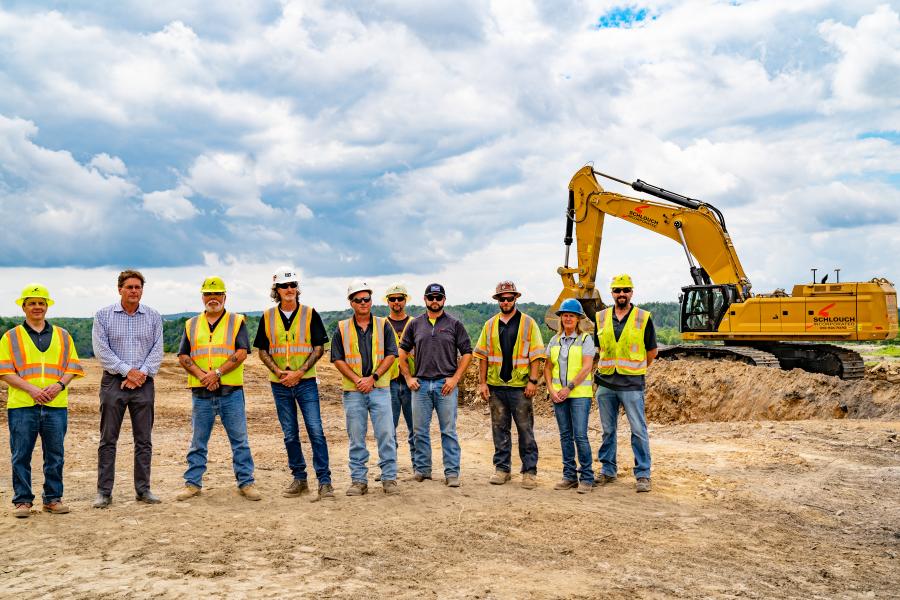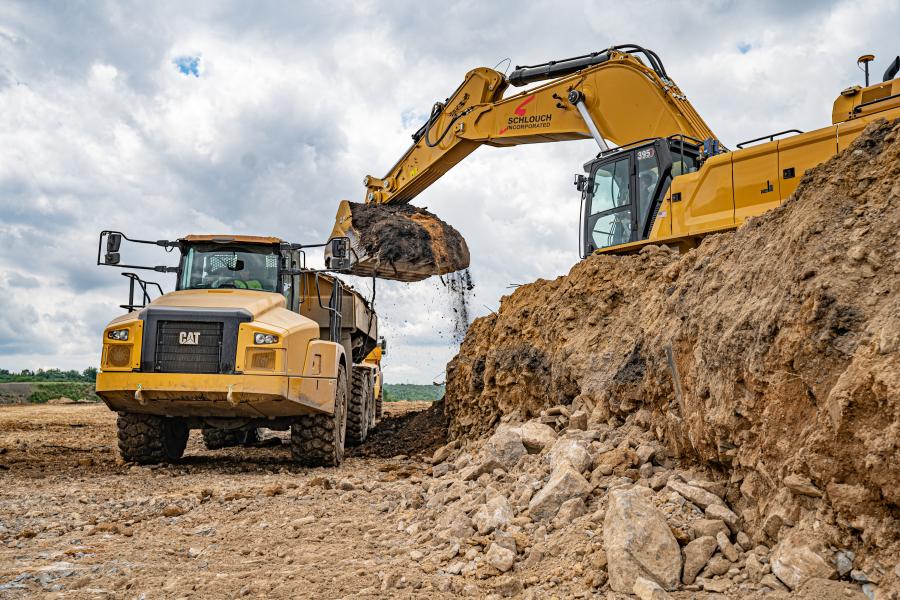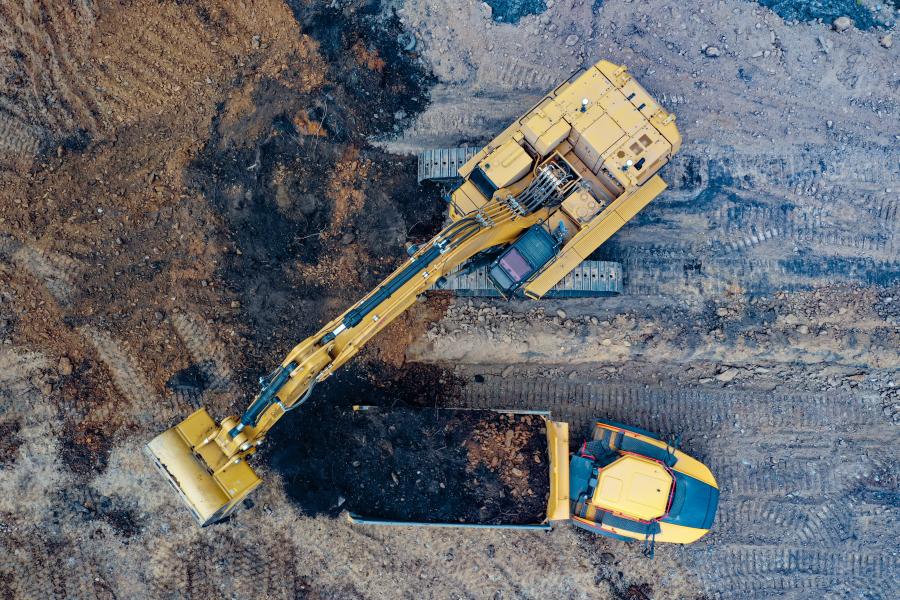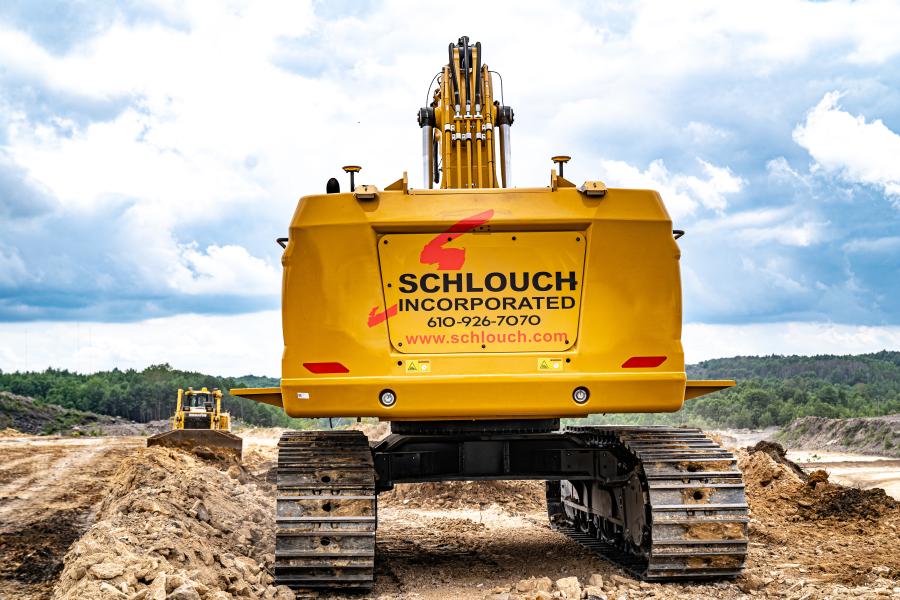Thu August 11, 2022
Craig Mongeau - CEG Editor in Chief
When a noted Pennsylvania grading and excavation company was faced with working on one of the biggest projects in its history, one that included filling in old strip-mining pits, its best minds convened to decide how to perform the project safely and efficiently.
Blandon, Pa.'s Schlouch Incorporated., a heavy civil contractor in business for almost 40 years, was tasked with clearing and grading a 362-acre site in eastern Pennsylvania earlier this year ahead of builders erecting the 5.5-million-sq.-ft. Hazleton Creek Commerce Center. The industrial park, east of Interstate 81, will be made up of five huge warehouses, ranging in size from 550,000 sq. ft. to 2.2 million sq. ft.
The contractor is well known in the region for its deep business relationships as well as for its ethics, integrity and focus on doing things right.

Its crews have worked on the Hazleton site since March to perform excavation for the pads upon which Building 4 and Building 5 will be built, part of Phase I. Later, Phase II will encompass the construction of Buildings 3, 2 and 1.
Hazelton Creek's warehouse structures also will feature 50-ft. building heights, more than 1,700 dedicated tractor trailer stalls, spaces for 2,700 cars and access to freight service via the Norfolk Southern line that runs along one edge of the park.
"This area is definitely where you want your company to be located," said Chief Operations Officer Don Swasing of Schlouch. "You can reach Interstate 81 and I-80 nearby to quickly take you into New York City, Philadelphia and other metro areas. We still have plenty of warehouse activity in the Lehigh Valley, but this area is the new frontier for eastern Pennsylvania."
Allied Building Corporation, based in Bethlehem, Pa., is the construction manager of the 5.5 million sq. ft. industrial park.
Schlouch's Internal Equipment Triangle Chooses Best Excavator for Project
The Hazleton site is in a ravine that had been both surface and deep mined from the early 19th century until the 1960s, leaving behind many strip pits and spoil piles. It also held two old landfills.
As a result, the location presents a challenge to any excavating contractor that has not studied the property carefully to find its potential hazards.
Schlouch analyzed the site prior to starting the job and identified the processes it needed to use to stabilize the earth under the planned business park.
In doing so, it also realized it needed a bigger mass excavator that had "the ability to move larger amounts of dirt and debris in less time," said Schlouch Site Superintendent Derek Bainbridge.

Specifically, the company wanted a machine perfectly suited to the site, and, in consultation with Schlouch's "Equipment Triangle," a group of three company executives that have the final say over any equipment purchase, Schlouch's Site Foreperson Andy Kelchner helped convinced the team to buy the huge Cat 395 hydraulic excavator.
The triumvirate included Swasing; Chief Financial Officer Richard King and Fleet Coordinator Kevin Reimert.
"What we found with our Equipment Triangle is if we consider the three perspectives — fleet, operations and financial — and look for three green lights, we make better decisions," King said. "We consider application, reliability, production and operational preference. On the fleet side, we evaluate longevity, maintenance and uptime. From a financial aspect, we look at how it impacts our rates and we consider utilization. In the end, we have learned this approach and a high level of collaboration is a better way to make decisions."
Swasing added, "Our focus as a team is on lowest cost, not lowest price. Employing our process allows us to find the path to the lowest cost. That is our advantage."
Once a decision is made, the contractor turned to Foley Inc., with locations in Piscataway, N.J., and Bensalem, Pa. Swasing described the dealership, which serves eastern Pennsylvania, New Jersey and Delaware, as one that is "joined at the hip" to Schlouch.
"Our up time is just as important to him as it is to us," he said about Foley's Vice President of Machine Sales Jeff Merle, "We know that at any time anywhere we can pick up the phone and someone from his group will be here to assist us."
The 207,000-lb. Cat 395 only came into Schlouch's possession, though, after both Cat and Foley met with the contractor to answer questions about the machine and present the data on how well the excavator has performed.
"When the folks at Schlouch were in the decision-making process of which brand manufacturer to purchase, Cat excavator product specialists met with them, along with Cat district representatives and Foley's executive leadership and sales reps, to discuss the contractor's questions, concerns, product features and benefits," said Sales Consultant Marty Lindmeier of Foley Inc.
Cat 395's Productivity Exceeds Expectations
With 16 pieces of iron equipment on the project, to date including excavators, haul trucks, loaders and dozers, Schlouch and its group of equipment decision makers concluded that the big Hazleton project required a big machine and the 542-hp Cat 395 fits the bill at the Hazleton job site.
The OEM bills the next-generation excavator as offering more production, more durability and less maintenance — traits that certainly drew the interest of Schlouch's Equipment Triangle. In addition, the 395 model has more swing torque and stick force, boasts a stronger structure than similar-sized models and has a max digging depth of almost 32 ft.
"For Cat customers stepping up to a 100-ton class excavator from smaller excavator classes, with the larger machine having a different life and maintenance cycles as well as different expectations — is almost like using a model from Cat's mining group," said Merle. "The intervals are longer, the life cycle is longer, there is more predictable uptime, so if you ever get to that point where you want to sell a 395, it is easier because it has great resale value."
Kelchner quickly became an advocate for the Cat 395 and believes the bigger, more powerful excavator will open new doors for Schlouch because it will be more competitive in its region when up for large mass earthmoving projects.
"With the new 395 model, we can move a lot of earth and save time," said Kelchner, who qualifies as an expert on the subject after having accrued more than 20,000 hours in the seat of big excavators. "We can handle projects of a larger magnitude with the group of guys we have now, not be tight against our resources and deliver on schedule. By bringing that Cat machine in, we can shrink down that schedule and do it safely. It is a different environment up here and a machine that size can handle all we can throw at it and remain reliable."

Much of the Cat 395's value, he said, comes from its size and the technologies it has that end up saving money over the long haul.
"First of all, having a GPS system on it was a must because it allows operators to know where they are at all times and it eliminates the need for an additional support machine for grading, meaning there is less congestion in the cut and a lower daily operations cost," said Kelchner.
He added that the Cat's automatic lubrication system, a new feature that increases the excavator's run time, keeps its downtime low and greases the machine's bearings and pins throughout the working day to prolong its life while also reducing wear on the 395, again, leading to lower operating costs.
This pair of advances in equipment design, Kelchner contended, are the biggest contributors to a grading contractor's ability to fully utilize every minute of every daily shift.
"We are seeing challenging schedules on these large projects, and they are getting more complex," King added. "With the schedules being tighter, one way to meet them and help our customers succeed is to be able to have that bigger machine that can do more or can accelerate the [the pace of work]. We now have the capability to do that on these larger, more complex warehouses."
Schlouch used to run double shifts, Kelchner said, but added that after dark, "operators are just not going to be able to see as well doing that. The 395, though, is a huge safety machine, so instead of dealing with a nighttime safety issue, you just eliminate it."
The operator assigned to run the Cat 395 loves the machine, Kelchner noted, particularly its size and ease of use. Phil Hobel is a bright young man who is a graduate of a vocational tech school and, so far, is not fazed by learning to work such a large excavator, said Kelchner.
"With a machine that size, and haul trucks to serve it, when you start to add the number of cycles with four or five trucks dumping 100 loads per day, that's a lot of movement in that cut."
Hazleton Work Site Brings Plenty of Challenges
Grading more than 5 million cu. yds. of dirt would be a massive enough project for any contractor. Schlouch, however, has been doing it for more than four months and, in the process, has added to its reputation for being able to find solutions to demanding projects.
The current work also is taking place entirely within the original cut. A substantial amount of blasting will take place in the Building 5 area and on the high side of the job at Building 4.
"This was one of the largest coal strip mines in the state back in the 1950s," Bainbridge said. "Hazleton City Hall used to sit on the property, but they moved it to another location to get to the coal. The mine was later abandoned in the 1990s."
Filling In Mine Pits Is Delicate Process
A total of 345 acres of the Hazleton Creek site is to be graded level over the next five years, according to Kelchner, with everything to be re-used, as well as trucking in more fill.
To reach its grade, Schlouch must fill dirt in the holes to come up about 20 ft., while on other parts of the fill it will need to go down not much more than about 20 ft., according to Kelchner. He said the deepest part of the fill is as much as 45 ft.
Dynamic Compacting an Effective, If Not Very Subtle, Method
Perhaps the most interesting process being used at the Hazleton work site is dynamic compaction, a method that increases the density of the soil deposits. By repeatedly dropping a heavy flat plate, attached to the end of a crane, another contractor on site does so to firmly compress the ground.
"They do that prior to [Schlouch] filling in the 20 feet," Bainbridge said. "We already leveled that off the ground so the crane can move about and just keep dropping the weight. Once he is done, we are allowed to then fill on top of the compacted earth. That happens before putting the base fill in if you are going up."
"It is a unique process just because all this land up here was used for so long as strip mines. The thing is you don't know, during [earlier] reclamation projects just exactly how they were reclaimed," Kelchner said. "From what we have been told, when the crane operator drops that weight at this site, it could compress that surface anywhere from two to 10 feet, depending on what materials are underground. It is always possible that we might have to go back in there to do some more fill."
Water Improvements Also Planned
Another challenge for Schlouch, as Bainbridge sees it, will be the installation of large, 96-in. reinforced concrete pipes (RCP) on the project.
"That will go right along the top of the Building 3 site," he said. "Just understanding the size of this pipe, how we are going to handle it and where it will go will be challenging."
In addition, four retention ponds also will be constructed, three of which will come into play in the next two months, according to Bainbridge. One, near Schlouch's staging area, is about the size of three football fields, and another is to be built by the contractor in a deep ravine near the project's entrance.
He noted that the pond excavations can be done before the overall project is fully at grade, "because the first one is a cut and the second is a fill. There also is a pond to build in Phase 2."
The active rail line on the property, a key selling point in leasing space to future business within Hazleton Creek, runs across the only roadway that Schlouch's crews are allowed to cross the tracks to get to that side of the job.
"Because the grade there is about 15 feet below the tracks, there are already a couple of walls in place," Kelchner said, noting that many more retaining walls will need to be built project wide. "To get the maximum footprint of the property that the owners want, there was no room to slope the hill all the way down without taking out parking, so we put in those retaining walls."
Schlouch Purchases Cat 395 After Much Analysis
Reimert said that Schlouch's method of deciding which construction equipment to buy or sell is a practice that many contractors do not employ, but he feels it is important in making a major capital investment.
"When you buy a machine of that size and magnitude, you really want to take the time to do it right and we did that," he said. "Every piece of the Triangle did its part. We wanted the latest and greatest in technology, we wanted to be safe about it and we had very specific production targets."

King felt confident that the executive team received solid intelligence on the Cat 395 that accurately reflected the cost of the machine.
"The other thing that Jeff [Merle] and Marty [Lindmeier of Foley] worked on was the structure of the deal," King said. "The way it was structured really helped us with the investment and we effectively redeployed the capital because we sold two Cat 627 scrapers and used that on the 395 excavator and some other assets."
President and Founder of Schlouch Incorporated Barry Schlouch summed up not only the significance of this project for his company, but also the importance of acquiring the Cat 395 excavator.
"We're humbled to earn the award of this project and we know that in order to attract, develop and retain the best employees in the industry, we must provide them with the best equipment, technology and tools to deliver great work," he said. "The addition of the Cat 395 excavator does just that."
For more information, visit www.schlouch.com and www.foleyinc.com. CEG
This story also appears on Construction Equipment Guide.
 Aggregate Equipment
Aggregate Equipment Articles
Articles Sign up for Updates
Sign up for Updates Sell Your Machines
Sell Your Machines

 Aggregate Equipment
Aggregate Equipment Aggregate Dealers
Aggregate Dealers Aggregate Articles
Aggregate Articles Sign up for Updates
Sign up for Updates Sell Your Machines
Sell Your Machines